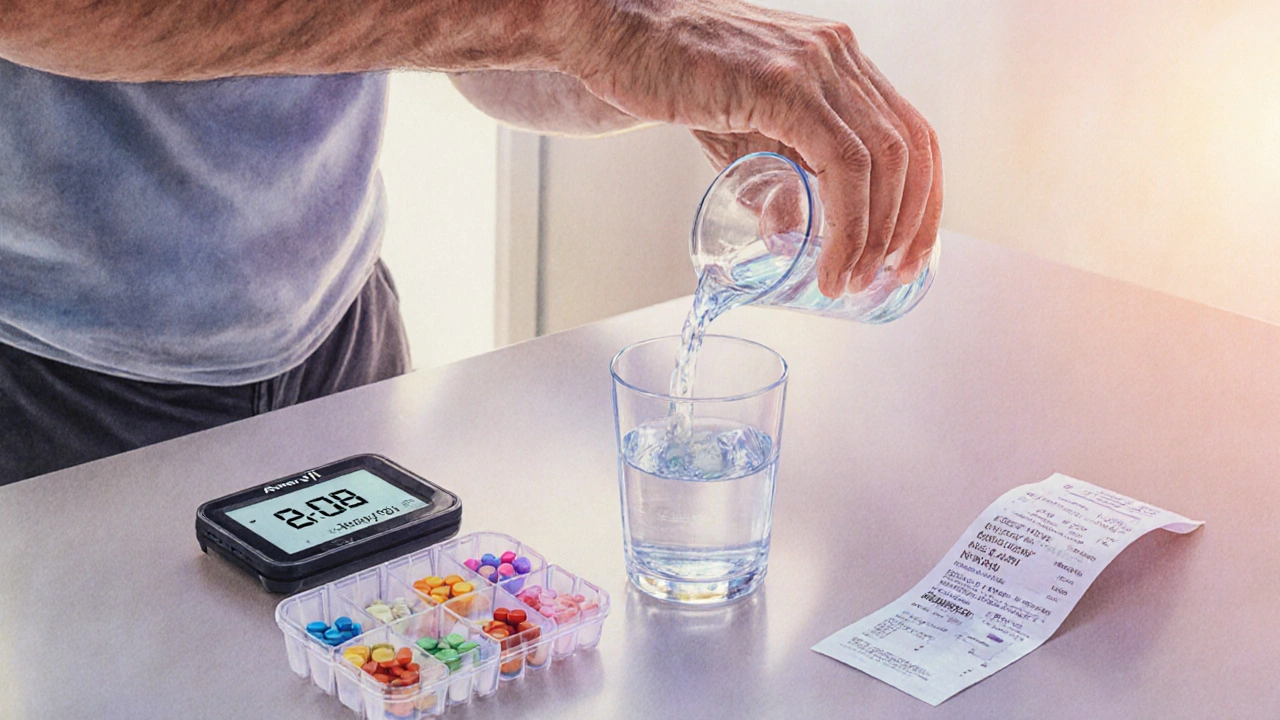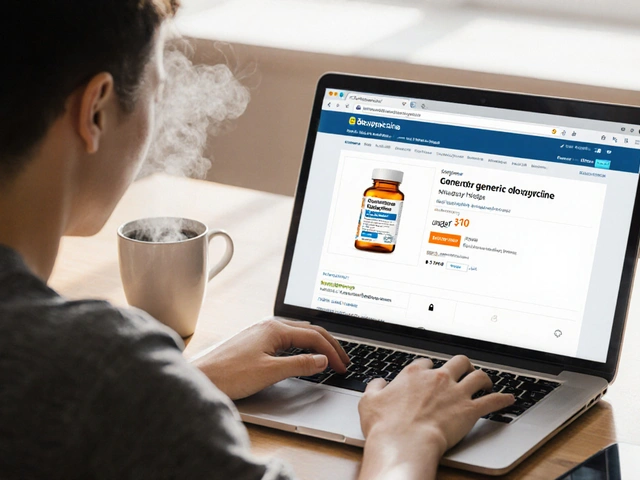Diabetes Medication Comparison Tool
Enter your health criteria below to find the best diabetes medication for you:
3 3 3 3| Medication | Class | Efficacy | Hypoglycemia Risk | Weight Impact | Cost (NZD/month) |
|---|---|---|---|---|---|
| Amaryl (Glimepiride) | Sulfonylurea | 3 | 4 | 0 | $10 |
| Metformin | Biguanide | 3 | 1 | -1 | $5 |
| Sitagliptin | DPP-4 Inhibitor | 2 | 1 | 0 | $90 |
| Empagliflozin | SGLT2 Inhibitor | 3 | 1 | -2 | $120 |
| Liraglutide | GLP-1 Agonist | 3 | 1 | -3 | $250 |
TL;DR
- Amaryl vs alternatives: Glimepiride is cheap and effective but carries higher hypoglycemia risk than newer agents.
- Metformin remains first‑line for most patients because of weight loss benefit and low cost.
- DPP‑4 inhibitors (e.g., sitagliptin) offer modest HbA1c drop with minimal hypoglycemia, but are pricier.
- SGLT2 inhibitors (e.g., empagliflozin) add heart‑protective benefits and weight loss, but need good kidney function.
- GLP‑1 agonists (e.g., liraglutide) provide the strongest weight loss and cardio benefit, but require injections.
What is Amaryl (Glimepiride)?
Amaryl (Glimepiride) is a sulfonylurea oral hypoglycemic used to lower blood glucose in adults with type2 diabetes. It works by stimulating the pancreas to release more insulin, which helps bring down the A1c by roughly 1-1.5% when taken as prescribed.
Glimepiride’s advantages are its low price and once‑daily dosing. The downside is a higher chance of low blood sugar, especially in older adults or those with irregular meals.
How Amaryl Stacks Up: The Criteria That Matter
When you compare any diabetes drug, you’re really weighing a handful of factors that affect daily life and long‑term health:
- Glycemic efficacy - how much the drug lowers A1c.
- Risk of hypoglycemia - dangerous drops in blood sugar.
- Weight impact - does it cause weight gain, loss, or is neutral?
- Cardiovascular & renal outcomes - any proven heart or kidney protection?
- Cost & insurance coverage - out‑of‑pocket expense in NZ.
- Convenience - pill vs injection, dosing frequency, food requirements.
Below we line up Amaryl against the most common alternatives that doctors prescribe after or alongside metformin.

Side‑by‑Side Comparison Table
| Medication | Drug Class | Typical Daily Dose | Avg. HbA1c ↓ | Hypoglycemia Risk | Weight Effect | Cardio‑Renal Benefit | Approx. NZD/Month |
|---|---|---|---|---|---|---|---|
| Amaryl (Glimepiride) | Sulfonylurea | 1-4mg | 1.0-1.5% | Moderate‑High | ±0kg (neutral) | None proven | ≈$10 |
| Metformin | Biguanide | 500‑2000mg split BID | 0.8-1.2% | Low | ‑1kg (modest loss) | Reduces CV events, renal protection | ≈$5 |
| Sitagliptin | DPP‑4 inhibitor | 100mg | 0.5-0.8% | Low | ±0kg | Neutral | ≈$90 |
| Empagliflozin | SGLT2 inhibitor | 10‑25mg | 0.6-1.0% | Low | ‑2kg | ↓ CV death, ↓ HF hospitalisation, renal benefit | ≈$120 |
| Liraglutide | GLP‑1 receptor agonist | 0.6‑1.8mg subQ daily | 1.0-1.5% | Low | ‑3kg | ↓ CV events, ↓ weight, renal benefit | ≈$250 |
| Glyburide | Sulfonylurea | 2.5‑10mg | 1.0-1.4% | High | ±0kg | None proven | ≈$8 |
| Pioglitazone | Thiazolidinedione | 15‑45mg | 0.5‑1.0% | Low | +2kg (weight gain) | ↓ CV events in some groups | ≈$30 |
Deep Dive into the Alternatives
Metformin stays at the top of most guidelines because it lowers glucose without causing hypoglycemia, can promote modest weight loss, and has proven heart‑protective data. It’s also the cheapest option, making it the go‑to for most NewZealand patients.
Sitagliptin (a DPP‑4 inhibitor) is popular for people who can’t tolerate metformin’s GI side effects. It’s safe on the stomach and rarely causes low sugar, but the cost is roughly ten times higher than metformin.
Empagliflozin belongs to the newer SGLT2 inhibitor class. Besides a decent A1c drop, it helps shed pounds and reduces the risk of heart failure and kidney disease. The catch? It needs adequate kidney function and can increase urinary tract infection risk.
Liraglutide is a GLP‑1 agonist given as a daily injection. It delivers the biggest weight loss and the strongest cardiovascular protection, but the price and injection requirement keep it as a second‑line or specialist‑prescribed option.
Glyburide is another sulfonylurea that works similarly to glimepiride but has a higher hypoglycemia profile, especially in the elderly. It’s cheap, but most clinicians favor glimepiride over glyburide for safety.
Pioglitazone improves insulin sensitivity and may lower macro‑vascular events, yet it often causes fluid retention and weight gain, limiting its use in patients with heart failure.
Choosing the Right Drug for You
Think of the decision as matching a tool to a job. Ask yourself:
- Do I need the cheapest, tried‑and‑true option? Metformin or glimepiride fits.
- Is weight loss a priority? Consider empagliflozin or liraglutide.
- Do I have heart failure or chronic kidney disease? Empagliflozin often wins.
- Am I worried about low blood sugar? Pick sitagliptin, empagliflozin, liraglutide, or stay on metformin alone.
- Can I afford a higher monthly cost? Budget‑friendly choices are glimepiride, metformin, glyburide.
Always discuss these factors with your GP or endocrinologist. Lab results, lifestyle, and personal preferences shape the final prescription.
Practical Tips & Common Pitfalls
- Start low, go slow. With sulfonylureas like glimepiride, begin at the lowest dose to gauge hypoglycemia risk.
- Take glimepiride with meals. Eating soon after dosing reduces the chance of a sugar crash.
- Monitor kidney function. SGLT2 inhibitors require an eGFR >45mL/min/1.73m² for full benefit. li>Watch for GI upset. Metformin can cause nausea; a slow titration or extended‑release formulation often helps.
- Don’t mix sulfonylureas with other high‑risk hypoglycemics. Combining glimepiride with insulin can amplify low‑sugar episodes.

Frequently Asked Questions
Can I switch from glimepiride to a newer drug without stopping metformin?
Yes. Many doctors add an SGLT2 inhibitor or DPP‑4 inhibitor while keeping metformin on board. The switch is usually done gradually, reducing the sulfonylurea dose over a couple of weeks to avoid hypoglycemia.
Why does glimepiride cause weight gain in some people?
Glimepiride forces the pancreas to release more insulin. Higher insulin levels can promote fat storage, especially if calorie intake isn’t adjusted.
Is glimepiride safe for older adults?
It can be used, but the hypoglycemia risk rises with age. A lower starting dose (0.5mg) and careful blood‑sugar monitoring are recommended.
Do SGLT2 inhibitors replace the need for sulfonylureas?
In many cases they do, because they lower glucose without causing hypoglycemia and add heart‑protective benefits. However, cost and kidney function may keep sulfonylureas in the toolbox for some patients.
How often should I get my A1c checked after changing medication?
Typically every 3months until the new regimen stabilises, then every 6months for ongoing monitoring.







Write a comment
Your email address will be restricted to us